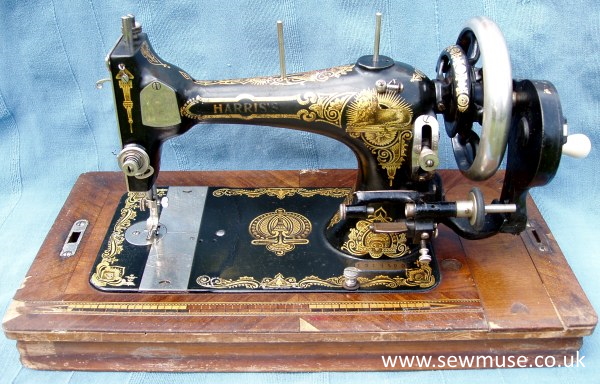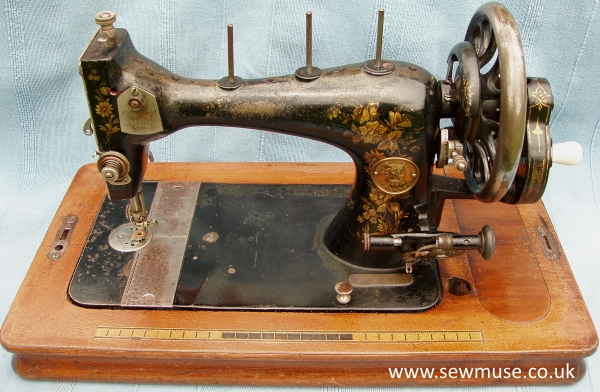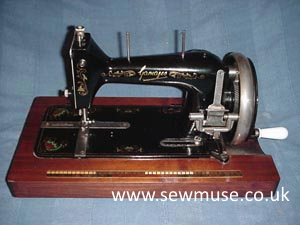With the introduction of Singers V.S. 2 and V. S. 3 the German sewing machine industry developed its own versions. These machines can perhaps be best described as solid workhorses, the machines and bases tend to be larger. Gone are the small pretty flowers and Mother of Pearl inlay, instead the machines tend to have simpler gold flower decals. Then in the 1920's the decals were simplified further in keeping with the popular Art Deco style, cases as well became less intricate.
After World War One machines were still produced for export to Great Britain but by fewer companies and not in the quantities of earlier decades. Although badging was still common instead of "Made in Germany" the word "Foreign" was sometimes used. As well as Vibrating Shuttle machines, the High Arm Family and Saxonia style machines were still being produced.
German Vibrating Shuttle machines are perhaps less common than other types, but prices tend to be about the same as for the High Arm Family machines. Most of the V.S. machines we come across seem to be in reasonable condition perhaps reflecting the changing times with less dressmaking and more off the peg clothes being sold.
Germany also had a significant Toy Sewing machine industry from c1880's onwards, perhaps the best known is F. W. Muller (not to be confused with Clemens Muller). The company's Berlin factory produced an incredible range of toy machines both cast and tin plate. Casige was another famous company producing toy machines from c1903. These toy machines produce a chain stitch and often have external workings. Generally they are easy to find although like their full size counterparts there are some very rare examples.

Harris's: Serial No. 1015499.
This machine was made in Stettin around 1910 by Bernhard Stoewer AG. The firm was founded in 1858 by Bernhard Stoewer and became a corporation in 1896.
In 1893 the firm diversified into the production of bicycles and started producing typewriters in 1903.
Production of sewing machines peaked in 1905 with about 75,000 machines being made but sales declined and in 1931 having produced some 1,870,000 the sewing machines the sewing machine division was sold to Adolf Knoch.
This machine is labelled Harris's on the arm and stamped on the front slide plate is W. J. Harris & Co Ltd London Manufacturer Made in Stettin.
Harris was a multi-branch retailer which sold mainly German made machines.

M ller Veritas: Serial No. 1577896.
Made by Clemens M ller who was Germany's first sewing machine manufacturer starting production in 1855 in Dresden.
By 1875 a 100,000 machines of various types including industrial models had been produced.
This increased to 200,000 by 1880 and by 1930 production totalled almost 3 million machines.
After World War 2 the company was renamed VEB Writing & Sewing Machines reflecting that it had been producing type writers since 1910.
The name Veritas appeared on all machines this firm exported after 1905 and on this machine it is just visible on the arm.
The decals are in very poor condition, the machine having been well used, there is pin rash down to the bare metal on the
arm.
The decals are completely gone on the bed, but still evident on the shoulder, they must have been very pretty.
Unusually it has 3 spool pins. Mechanically it purrs.

Gamages: Serial No. 283597.
Made in Germany between 1936 and 1939 and badged for Gamages which was a large London Department store.
The machine is half size with recessed crank and uses a boat shuttle.
The decals are in good condition with "Gamages" on the side of the arm and "Foreign" on the top.
It came with a wooden case covered with leatherette. The front drops down to reveal the machine, which slides out and there's a small drawer in the top left of the case. This particular design of case was introduced in 1936.
The manual is entitled "The Hand Sewing Machine Class 1 (Long Shuttle System)" and refers to needle No 705. It has photos in the instructions instead of line drawings.


